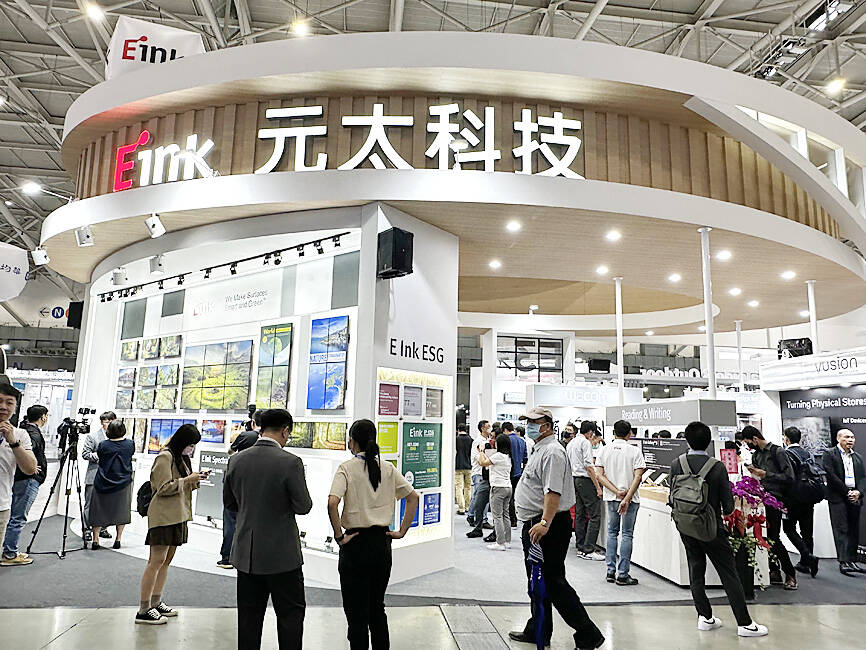E-paper display supplier E Ink Holdings Inc (元太科技) yesterday said its revenue growth is to recover this year as its customers rapidly adopt new four-color e-paper displays used in electronic shelf labels (ESLs).
Last year, customers’ inventory adjustments of previous-generation three-color e-paper displays slowed down their transition to new four-color e-paper displays for ESL and constrained E Ink’s revenue growth, the firm said.
The supply chain issue “is not a concern now,” E Ink chairman Johnson Lee (李政昊) told investors yesterday, adding that customers’ inventories are expected to return to a healthy level this quarter.

Photo: Chen Mei-ying, Taipei Times
In addition, the supply of driver ICs and display modules used in the new ESL displays are expected to improve this year, he said.
“The first quarter will be the trough for the ESL business, which will improve every quarter this year,” Lee said.
Feedback from its partners showed that about 80 percent of its customers plan to adopt four-color e-paper displays this year, compared with 20 percent in October last year, he said.
“Overall, the outlook for 2024 will be better than 2023,” Lee said. “Revenue this year will also be higher than last year, with the growth rate hinging on customers’ product transitions.”
E Ink posted revenue of NT$27.12 billion (US$861 million) for last year, down 9.78 percent from NT$30.06 billion in 2022.
In contrast to the clearer visibility for its ESL business, e-paper for consumer electronic applications — mostly e-readers and e-notes — are a “wild card” this year, Lee said, citing customers’ delayed launches of new models equipped with color displays instead of monochrome displays.
E Ink said its capacity expansion plans are on schedule, with the new production line in Hsinchu, dubbed H5, likely to enter volume production in the fourth quarter at the earliest to produce large-size e-paper displays measuring 85 inches to 95 inches (216cm to 241cm) for outdoor signages.
Another new production line, H6, is to enter operation in 2026 to manufacture even larger e-paper displays, the firm said.
The company has decided to restart its new plant construction in Taoyuan’s Guanyin District (觀音) this year, and is expanding module capacity at its Yangzhou plant in China for super-large e-paper displays from 75-inch to 100-inch displays, it said.
The Hsinchu-based company’s net profit fell 21 percent last year to NT$7.82 billion, from NT$9.91 billion a year earlier, and earnings per share dropped to NT$6.85, from NT$8.69.
Non-operating profit shrank 12 percent annually to NT$2.54 billion, attributable to a dip of 60 percent in royalty income, it said. Since 2019, E Ink has generated more operating income than the income from licensing its display patents, it added.
The firm’s board of directors last month approved a cash dividend distribution of NT$4.5 per share, with a payout ratio of 66 percent, up from 52 percent the previous year.

STEEP DECLINE: Yesterday’s drop was the third-steepest in its history, the steepest being Monday’s drop in the wake of the tariff announcement on Wednesday last week Taiwanese stocks continued their heavy sell-off yesterday, as concerns over US tariffs and unwinding of leveraged bets weighed on the market. The benchmark TAIEX plunged 1,068.19 points, or 5.79 percent, to 17,391.76, notching the biggest drop among Asian peers as it hit a 15-month low. The decline came even after the government on late Tuesday authorized the NT$500 billion (US$15.2 billion) National Stabilization Fund (國安基金) to step in to buoy the market amid investors’ worries over tariffs imposed by US President Donald Trump. Yesterday’s decline was the third-steepest in its history, trailing only the declines of 2,065.87 points on Monday and

TAKING STOCK: A Taiwanese cookware firm in Vietnam urged customers to assess inventory or place orders early so shipments can reach the US while tariffs are paused Taiwanese businesses in Vietnam are exploring alternatives after the White House imposed a 46 percent import duty on Vietnamese goods, following US President Donald Trump’s announcement of “reciprocal” tariffs on the US’ trading partners. Lo Shih-liang (羅世良), chairman of Brico Industry Co (裕茂工業), a Taiwanese company that manufactures cast iron cookware and stove components in Vietnam, said that more than 40 percent of his business was tied to the US market, describing the constant US policy shifts as an emotional roller coaster. “I work during the day and stay up all night watching the news. I’ve been following US news until 3am

Six years ago, LVMH’s billionaire CEO Bernard Arnault and US President Donald Trump cut the blue ribbon on a factory in rural Texas that would make designer handbags for Louis Vuitton, one of the world’s best-known luxury brands. However, since the high-profile opening, the factory has faced a host of problems limiting production, 11 former Louis Vuitton employees said. The site has consistently ranked among the worst-performing for Louis Vuitton globally, “significantly” underperforming other facilities, said three former Louis Vuitton workers and a senior industry source, who cited internal rankings shared with staff. The plant’s problems — which have not

TARIFF CONCERNS: The chipmaker cited global uncertainty from US tariffs and a weakening economic outlook, but said its Singapore expansion remains on track Vanguard International Semiconductor Corp (世界先進), a foundry service provider specializing in producing power management and display driver chips, yesterday withdrew its full-year revenue projection of moderate growth for this year, as escalating US tariff tensions raised uncertainty and concern about a potential economic recession. The Hsinchu-based chipmaker in February said revenues this year would grow mildly from last year based on improving supply chain inventory levels and market demand. At the time, it also anticipated gradual quarter revenue growth. However, the US’ sweeping tariff policy has upended the industry’s supply chains and weakened economic prospects for the world economy, it said. “Now